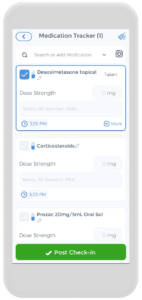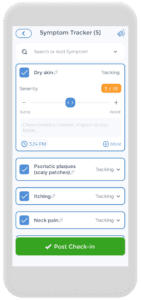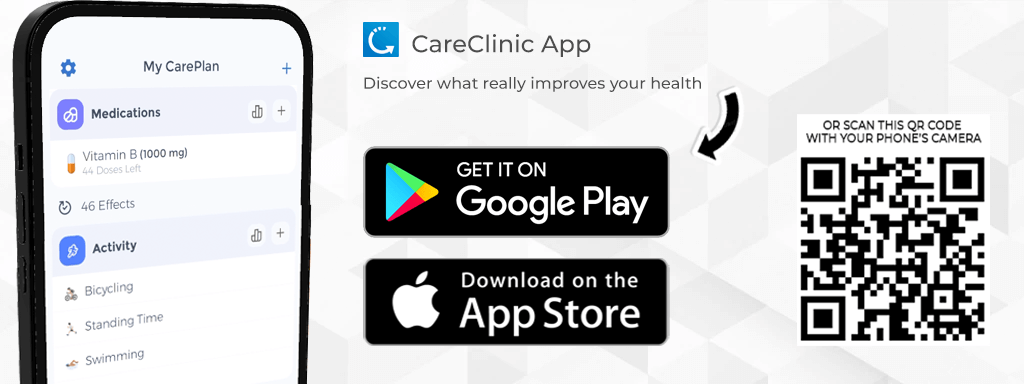 Psoriasis is a chronic autoimmune skin condition that affects millions of people worldwide. While there’s no cure for psoriasis, there are many treatments and lifestyle changes you can make to manage your symptoms and improve your quality of life. In this article, we’ll cover everything you need to know about tracking and managing your psoriasis symptoms at home.
Psoriasis is a chronic autoimmune skin condition that affects millions of people worldwide. While there’s no cure for psoriasis, there are many treatments and lifestyle changes you can make to manage your symptoms and improve your quality of life. In this article, we’ll cover everything you need to know about tracking and managing your psoriasis symptoms at home.
Understanding Psoriasis
Psoriasis is an autoimmune disease that affects millions of people worldwide. It is a chronic condition that causes inflammation in the skin, leading to the development of red, scaly patches. These patches can be itchy, painful, and embarrassing, making the itchy skin condition very difficult for those affected to go about their daily lives.
that causes inflammation in the skin, leading to the development of red, scaly patches. These patches can be itchy, painful, and embarrassing, making the itchy skin condition very difficult for those affected to go about their daily lives.
While plaque psoriasis can occur anywhere on the body, commonly psoriasis affects the scalp, elbows, knees, and lower back. The severity of psoriasis symptoms can vary from person to person, with some experiencing only mild symptoms and others experiencing more severe psoriasis symptoms that can affect their quality of life.
Types of Psoriasis
There are several types of psoriasis, each with its unique characteristics and symptoms. The most common type of psoriasis is plaque psoriasis, which accounts for about 80% of all cases. Plaque psoriasis presents as raised, red, and scaly patches that can be itchy and painful.
Guttate psoriasis is another type of psoriasis that often appears in children and young adults. This type of psoriasis presents as small, red, and scaly spots on the skin.
Inverse psoriasis is a type of psoriasis that affects the folds of the skin, such as the armpits or groin. Inverse psoriasis presents as smooth, red, and shiny patches of skin folds that can be itchy and painful.
Pustular psoriasis is a rare type of psoriasis that presents as small, pus-filled blisters on the skin. Pustular psoriasis can be painful and requires immediate medical attention.
Erythrodermic psoriasis is the least common type of psoriasis but is also the most severe. Erythrodermic psoriasis presents as widespread redness and scaling of the skin, often accompanied by severe itching and pain.
Common Triggers and Causes
The exact cause of psoriasis remains unknown, but experts believe it results from a combination of genetic, environmental, and and overactive immune system factors. People with a family history of psoriasis are more likely to develop the condition, but it can also occur in people with no other type of psoriasis, prevalence or family history.
Environmental factors, such as stress, injury to the skin, and certain medications, can trigger psoriasis symptoms. Infections, such as strep throat or skin infections, can also trigger psoriasis symptoms in some people.
It’s essential to understand the triggers and causes of psoriasis to better manage the condition. Working with a healthcare provider to develop a treatment plan that addresses your unique symptoms and triggers can help you live a more comfortable and fulfilling life with psoriasis.
Importance of Tracking Symptoms
Psoriasis is a chronic autoimmune condition that affects the skin, causing red, scaly patches. Managing psoriasis can be challenging, but one of the most critical aspects of managing your psoriasis is identifying your triggers.
Identifying Triggers
Keeping track of your symptoms and what you’re doing when they occur can help you pinpoint what triggers your symptoms. Common triggers include stress, using certain medications, foods, alcohol, and smoking. By tracking your symptoms, you can identify patterns and take steps to avoid triggers that exacerbate your plaque psoriasis.
For example, if you notice that your psoriasis flares up after eating certain foods, you can adjust your diet to avoid those foods. Alternatively, if you notice that stress is a trigger, you can practice stress-management techniques, such as meditation or yoga.
Monitoring Treatment Progress
Keeping track of your symptoms also allows you to monitor how your treatment is progressing. If something isn’t working, you can make adjustments or try a different approach. Monitoring your progress can also help you and your healthcare provider determine if a change in treatment is necessary.
There are many treatments available for plaque psoriasis, including topical creams, phototherapy, and systemic medications. By tracking your symptoms, you can determine which treatments are most effective for how psoriasis affects you and make informed decisions about your care.
Improving Quality of Life
Tracking your symptoms helps you better understand your condition and how to manage it. By identifying triggers, understanding your treatment options, and monitoring your progress, you can take control of your plaque psoriasis and improve your quality of life.
Psoriasis can be a frustrating and unpredictable condition, but tracking your symptoms can help you feel more in control. By taking an active role in managing your skin disease, you can reduce the frequency and severity of flare-ups and enjoy a better quality of life.
It’s important to remember that psoriasis is a chronic condition, and there is no cure. However, with the right treatment and self-care strategies, you can manage your symptoms and live a full and active life.
Methods for Tracking Psoriasis Symptoms
Psoriasis is a chronic autoimmune condition that affects the skin, causing red, scaly patches. While there is no cure for psoriasis, there are many treatments available that can help manage the symptoms. One effective way to manage your psoriasis is to track your symptoms over time. This can help you identify triggers, monitor your progress, and make informed decisions about your treatment plan.
Keeping a Symptom Journal
Keeping a symptom journal is an effective way to track your psoriasis symptoms. By recording when your symptoms occur, what triggers them, and any treatments you’re using, you can identify patterns and better manage your condition. You can use a notebook or a mobile app to keep track of your symptoms. In your journal, be sure to include information about the severity of your symptoms, the location of your psoriasis patches, and any other relevant details.
Tracking your symptoms over time can also help you and your healthcare provider make informed decisions about your treatment plan. By identifying patterns in your symptoms, you can determine which treatments are most effective for you and adjust your plan accordingly.
Using Mobile Apps
In addition to a symptom journal, there are many mobile apps, such as the CareClinic App, available that can help you track your psoriasis symptoms. These apps allow you to log your symptoms, track your progress, set reminders for medications, and connect with other people living with psoriatic disease. Some apps even use artificial intelligence to analyze your symptoms and provide personalized treatment recommendations.
When choosing a mobile app, be sure to look for one that is user-friendly and has features that are important to you. For example, if you’re interested in connecting with other people living with psoriasis, look for an app that has a social component. If you’re interested in tracking your progress over time, look for an app that allows you to take and store photos of your psoriasis patches.
Taking Regular Photos
Taking photos of your psoriasis regularly can help you monitor your progress over time. You can use these photos to track changes in the size, shape, and color of your psoriasis patches. This tracking method can be especially helpful if you have psoriasis in hard-to-reach areas or if you’re using a topical treatment.
When taking photos, be sure to use consistent lighting and positioning to ensure accurate comparisons. You may also want to consider taking photos at regular intervals, such as once a week or once a month, to track changes over time.
Overall, tracking your psoriasis symptoms is an important part of managing your condition. By keeping a symptom journal, using a mobile app, and taking regular photos, you can identify triggers, monitor your progress, and make informed decisions about your treatment plan.
At-Home Treatments for Psoriasis
Psoriasis is a chronic skin condition that affects millions of people worldwide. While there’s no cure for psoriasis, there are several at-home treatments that can help manage symptoms and improve quality of life. In this article, we’ll discuss some of the most effective at-home treatments for psoriasis.
Topical Treatments
 Topical treatments involve applying creams, ointments, or lotions directly to the affected skin. These treatments can help reduce inflammation, itching, and scaling of dry skin. Common topical treatments for psoriasis include corticosteroids, calcitriol, and coal tar.
Topical treatments involve applying creams, ointments, or lotions directly to the affected skin. These treatments can help reduce inflammation, itching, and scaling of dry skin. Common topical treatments for psoriasis include corticosteroids, calcitriol, and coal tar.
Corticosteroids are anti-inflammatory medications that can help reduce redness, itching, and swelling. Calcitriol is a synthetic form of vitamin D that can help slow the growth of new skin cells. Coal tar is a byproduct of coal that can help reduce scaling and inflammation.
When using topical treatments, it’s essential to follow the instructions carefully and use them as directed. Overuse of these treatments can lead to skin thinning and other side effects.
Light Therapy
Light therapy, or phototherapy, involves exposing the skin to UVB or UVA light to reduce inflammation and improve symptoms. Light therapy can be administered at home using a UVB lamp, but it should be supervised by a healthcare provider.
UVB light therapy is the most common form of light therapy for psoriasis. It works by slowing the growth of skin cells and reducing inflammation. UVA light therapy is less commonly used and requires the use of a photosensitizing medication.
When using light therapy, it’s crucial to protect the eyes and unaffected skin from exposure to UV light. Long-term exposure to UV light can increase the risk of skin cancer.
Natural Remedies
While there’s no cure for psoriasis, some natural remedies can help manage symptoms. These remedies include using aloe vera, omega-3 fatty acids, and vitamin D supplements.
Aloe vera is a plant that has been used for centuries to treat skin conditions. It contains anti-inflammatory compounds that can help reduce redness and scaling. Omega-3 fatty acids are found in fatty fish and can help reduce inflammation throughout the body. Vitamin D supplements can help slow the growth of skin cells.
It’s essential to talk to your healthcare provider before trying any natural remedies. Some natural remedies can interact with medications and cause side effects.
In conclusion, at-home treatments for psoriasis can help manage symptoms and improve quality of life. Topical treatments, light therapy, and natural remedies used for a few weeks are all effective options for managing psoriasis. It’s essential to work with a healthcare provider to develop a treatment plan that’s right for you.
Lifestyle Changes to Manage and Prevent Psoriasis
Psoriasis is a chronic autoimmune condition that affects the skin, causing red, scaly patches that can be itchy and painful. While there is no cure for psoriasis, there are many ways to manage the symptoms and improve quality of life. In addition to medical treatments, making lifestyle changes can also help manage psoriasis symptoms.
Stress Management Techniques
Stress can worsen psoriasis symptoms by triggering inflammation in the body’s immune system. Therefore, learning stress management techniques like yoga, deep breathing exercises, and meditation can help manage your symptoms. These practices can help reduce stress and promote relaxation, which can in turn reduce inflammation and improve skin health. In addition, reducing stress can improve your overall quality of life.
Diet and Nutrition
While there is no specific diet for psoriasis treatment, certain foods may worsen symptoms in some people. For example, dairy products and gluten-containing foods have been known to trigger inflammation in some individuals. Eating a balanced, nutritious diet that includes plenty of fruits, vegetables, and lean proteins can help support overall health and well-being. Some studies have also suggested that omega-3 fatty acids, found in fatty fish like salmon and tuna, may have anti-inflammatory effects that can benefit psoriasis patients.
Exercise and Physical Activity
Regular exercise and physical activity can also help manage psoriasis symptoms. Exercise can reduce stress and promote healthy circulation, which can improve symptoms and overall health. In addition, exercise can help maintain a healthy weight, which is important for psoriasis patients as obesity has been linked to more severe psoriasis symptoms. However, it’s important to avoid overexertion or activities that may cause skin irritation or injury.
In conclusion, making lifestyle changes can be an important part of managing psoriasis symptoms. By learning stress management techniques, eating a balanced diet, and engaging in regular exercise, psoriasis patients can improve their overall health and well-being, as well as reduce the severity of their symptoms.
When to Seek Professional Help
Psoriasis is a chronic autoimmune condition that affects the skin, causing red, scaly patches that can be itchy and painful. While there are many treatments available to manage psoriasis symptoms, sometimes it is necessary to seek professional help.
Signs Your Psoriasis is Worsening
It is important to be aware of the signs that your psoriasis is worsening so that you can seek help as soon as possible. Some signs to look out for include:
- An increase in the size or number of patches
- Increased itchiness or pain
- The appearance of new patches
If you notice any of these signs, it may be time to seek professional help.
Finding a Dermatologist
If you need professional help managing your symptoms of psoriasis, a dermatologist can help. Dermatologists specialize in skin conditions and can prescribe medications and treatments to help manage psoriasis. They can also provide advice on how to manage your symptoms at home.
When looking for a dermatologist, it is important to find someone who is experienced in treating psoriasis. You can ask your primary care physician for a referral, or you can search for a dermatologist in your area online.
Preparing for Your Appointment
Before your appointment, make a list of your symptoms and any medications or treatments you’re using. This information will help your dermatologist develop an effective treatment plan. It is also a good idea to bring a list of questions to ask your dermatologist, such as:
- What treatments are available for my psoriasis?
- What are the potential side effects of these treatments?
- How can I manage my symptoms at home?
By being prepared for your appointment, you can make the most of your time with your dermatologist and get the help you need to manage your psoriasis symptoms.
Using the CareClinic App For Your Psoriasis Treatment Plan
Having a plaque psoriasis action plan is crucial, and the CareClinic app can help with that. You can use the app as your skin disease diary. Just go to the diary section of the app and enter your daily symptoms, medications, and triggers as they occur. There are also specific sections on the app to track each of these. Next time you visit the doctor, this information will be handy in your pocket.
Whether you develop psoriatic arthritis, plaque psoriasis, pustular psoriasis, guttate psoriasis, inverse psoriasis, nail psoriasis, scalp psoriasis, erythrodermic psoriasis, or another skin disorder, our goal is to help with disease control and help you reduce symptoms such as pus filled bumps, intense itching, cracked skin, skin patches, discolored skin, scaly skin cells, sore throat, dry skin, and more. Furthermore, we want to help you prevent complications like liver disease, celiac disease, heart disease, or swollen joints.
Final Thoughts on Psoriasis
 Psoriasis is a chronic autoimmune condition that affects millions of people worldwide. It can cause a range of symptoms, including red, scaly patches on the skin, itching, and joint pain. Managing psoriasis can be challenging, but there are steps you can take to improve your quality of life.
Psoriasis is a chronic autoimmune condition that affects millions of people worldwide. It can cause a range of symptoms, including red, scaly patches on the skin, itching, and joint pain. Managing psoriasis can be challenging, but there are steps you can take to improve your quality of life.
One of the most important things you can do is to track your symptoms. Keeping a record of when your symptoms flare up and what triggers them can help you identify patterns and make lifestyle changes that can reduce your symptoms. For example, if you notice that your psoriasis flares up after eating certain foods, you may want to try eliminating those foods from your diet.
Another key factor in managing psoriasis is making lifestyle changes. This can include things like quitting smoking, reducing stress, and getting regular exercise. All of these things can help reduce inflammation in the body, which is a key factor in developing psoriasis.
In addition to lifestyle changes, there is also a range of medical and other treatments available for psoriasis. These can include topical steroids, oral medications, and light therapy. Your healthcare provider can work with you to develop a comprehensive management plan that takes into account your individual needs and preferences.
It’s important to remember that psoriasis is a chronic condition, and there is no cure. However, with the right management plan, you can take control of your symptoms and improve your quality of life. If you’re struggling with psoriasis symptoms, don’t hesitate to talk to your healthcare provider about your options.
Sources:
- https://my.clevelandclinic.org/health/diseases/6866-psoriasis
- https://www.aad.org/public/diseases/psoriasis/what/symptoms
- https://www.webmd.com/skin-problems-and-treatments/psoriasis/understanding-psoriasis-basics


